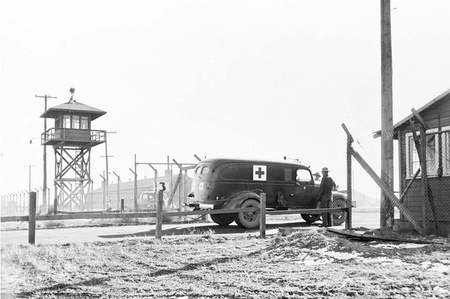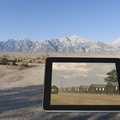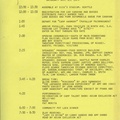Read Chapter 2 (1) >>
Criticism
By the time they reached high school, they had begun to criticize the government's methods, which were very different from the constitution that they had been taught in school to protect human rights. The following is a message left by Kaizo, a high school senior who is the older brother of one of Breed's children, Aiko Kubo.
My world was crumbling before my eyes. From the moment I stepped into the barbed wire fenced entrance to my destination, I felt something was wrong with me. The swagger I had maintained up until that moment had vanished, as if my soul had left my body. I was suddenly overcome by a feeling of insignificance and aloneness. The reality of being imprisoned dawned on me.
The cold, dark outline of the watchtower in the distance threatens me, bids me come. I hate its hideous size and the power it represents. I feel contempt for what it means. It reminds me of the inescapable fact that I am a prisoner.
Thus began my first steps as an insular. ... At first, I thought that if I could break the silence that surrounded me, something would happen. ... Twenty thousand souls were lost in thought. It was not going to be fun .
Something that stays in your mind
What left a deep impression on the children's minds were the high barbed wire fences, the soldiers with rifles, the watchtowers with machine guns, the nightly roll call, and the light of the searchlights shining into the rooms at regular intervals. Even as children, they sensed that this was a different place than they had known before. The first impression below is from Jean Oishi at Tulare Interment Camp, the impression about roll call is from a girl at Tanforan Interment Camp, and the last is from seven-year-old Ruth Okimoto at Santa Anita Interment Camp.
… We were surrounded by two high barbed wire fences. The two fences meant that we were locked up. If it had been a single fence, it would have been easy to see that the fences were there simply to mark the boundary of the area. But the Tulare facility looked exactly like a prison camp to anyone who saw it. Soldiers with sword-tipped rifles patrolled between the two fences. At first, some of us kids tried to make friends with the soldiers. We walked over to the fence and said, "Hey," but got no response. We sensed not only silence, but even a hint of hostility, so we left without doing anything more. There were guard towers along the fence, each with a half-inch machine gun attached to it. They were bulky, with barrels shaped like rolling pins. 2
Roll call was held every day at 6:30 p.m. Before roll call, I would play basketball or do the horizontal bar in the recreation hall. When the siren sounded (signaling that roll call was coming up), I was so scared that I would sometimes scream. People around me were more scared of my screams than the siren. We would hurry home and wait about five minutes, when the roll call officer would come and check that everyone was there. ...Then, when roll call was over, the siren would sound again to signal that roll call was over. ...I hated roll call because it made me so scared. 3
...My bed was next to an uncurtained window, and all night the light from the searchlight was hitting my face as I lay in bed trying to sleep, preventing me from falling asleep. Later I wrote a poem about it: "The darkness of my night stolen by the searchlight."

Experiences at the camps also vary by age. Even though they both involved searchlights, the experiences of 17-year-old Mary Matsuda at Pinedale Relocation Center were very different from those of 7-year-old Ruth. From Mary's recollections:
It was about 4am when I was going to go to the bathroom. I put on my coat over my pajamas and went outside, but I was immediately enveloped in a huge flash of light. It was so bright that I tried to hold my hands in front of my eyes, but then I realized that a searchlight from a nearby watchtower was focused on me. In the darkness, the searchlight was capturing my privacy and exposing it to the soldier in the watchtower. Dazzled and stunned, I felt violated. Not knowing how to stop the searchlight from focusing on me, I hurried back to the barracks. The light of the searchlight followed me, and continued to shine on the outside of the door even while I entered my house and held it down from inside (so that the light would not open the door by itself). After a while, the searchlight returned to its usual mechanical operation. Trembling, I thought to myself in the darkness of my room, "At 17 years old, I am a prisoner of my own country." 5
When Mary tells her family about this in the morning, she sees on her father's face a look of helplessness and frustration at being unable to protect his daughter from the searchlight.
work
What was Henry Miyatake doing at the Puyallup Temporary Internment Camp? He was actually working. It all started with eating in the communal dining hall. No one knew it at first, but eating in the dining hall would weaken family ties later on. However, for the children, being able to eat with their friends was a joy. Henry was one too. But the problem was that he was assigned a different meal time than his friends. Still, Henry decided to line up with his friends.
However, there was a Japanese-American attendant who was policing the long queue at the restaurant, and he would say, "You're from the wrong block," and pull you out. So I would either wait for my friends to eat and go play with them, or I would get angry at the attendant and not want to queue when it was my block's turn. ... The attendant was watching to make sure the same person didn't eat multiple times at once, and for some reason, he made a big enemy of me. ... One day, I was fed up with this and told my brother about it. He said, "...Hold on. They've got power now (which they don't usually have), so their egos are inflated, and they'll do anything." 6
Henry was about to say something, but his older brother stopped him and said, "Actually, we need more people to do electrical work. Henry knows more about electricity than any of your coworkers. Would you like to work in the electrical department?" There is a rule that you must be 16 years old or older to work in the camp, but in the chaotic situation, no one seemed to find fault with him, and 12-year-old Henry became the youngest crew member in the electrical department. Moreover, while working, he was able to enter the dining hall without having to line up, so he would briskly walk past the enforcement officer and head to the dining hall entrance every day.
Notes:
1. "Dear Breed" (see above)
2. Gene Oishi, translated by Someya Seiichiro, "Torn Identity: The Life of a Japanese Journalist," Iwanami Shoten, 1989
Gene Oishi's family was settled in the Tulare Internment Camp in California. The six members of his family, excluding his father who had been taken away by the FBI, lived in a room measuring 3.6 x 6 meters. What caught Gene's attention was the double-layered barbed wire fence and the watchtower equipped with a machine gun. The machine gun was pointed inside the camp, so even those who believed the government's words that the internment was to protect Japanese Americans from rioters were forced to face the reality.
3. Tunnell, Michael O. & Chilcoat, George W. The Children of Topaz: The Story of a Japanese-American Internment Camp , New York: Holiday House, Inc., 1996.
4. Ruth Y. Okimoto, interview by Tom Ikeda, April 8, 2011, Densho Visual History Collection, Densho.
5. Gruenewald, Mary Matsuda. Looking Like the Enemy: My Story of Imprisonment in Japanese-American Internment Camps. Troutdale: NewSage Press, 2005.
6. Henry Miyatake, interview by Tom Ikeda, May 4, 1998, Densho Visual History Collection, Densho.
*Reprinted from the 134th issue (July 2013) of “Children and Books,” a quarterly magazine published by the Children’s Library Association.
© 2013 Yuri Brockett






